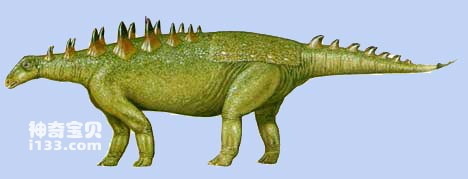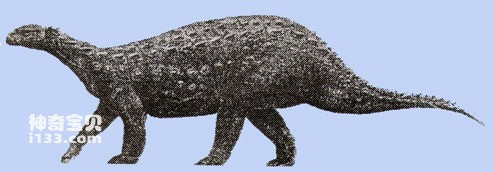The small tank-like dinosaur with hard armor on its body is called ankylosaurus. Various ankylosaurs combine to form a unique group in the dinosaur family, called ankylosaurs. Their taxonomic positions are Reptiles, Ornithischia, and Ankylosauria. Ankylosaurs are a relatively recent group in the dinosaur family, and they only just appeared on the stage of history at the end of the Jurassic.
1. Gastonosaurus
Recently, a strange early ankylosaurus was discovered in Utah in the western United States. They lived 125 million years ago. This kind of ankylosaurus is called Gastonosaurus. It is more than 5 meters long and weighs 1 to 2 tons.

Gastonosaurus
Gastonosaurus had thick legs and a low body close to the ground. Such a body structure obviously cannot run fast. The upper surface of their entire body is covered with hard bone plates and spurs, among which the towering spikes on the neck are more than 10 centimeters long. Such "heavy armor" can indeed deter most predators.
So, could Gastonosaurus simply ignore the greedy carnivorous dinosaurs around it and just live a leisurely life? Of course not, because in that world, many carnivorous dinosaurs threatened the safety of other animals all the time. At that time, there was a ferocious carnivorous dinosaur called Utahraptor roaming the western United States. They had keen eyesight and ran very fast. Their most powerful weapons were the long and sharp curves on their innermost fingers and toes. Its sharp claws can easily scratch animal skin two to three centimeters thick. Many vegetarian dinosaurs often fell victim to these claws.
Gastonosaurus, which is slow-moving and insensitive, is naturally often the target of Utah Robbersaurus' sneak attacks. When a Utahraptor targets a Gastonosaurus, the Utahraptor will pounce on it without the Gastonosaurus even realizing it. At this time, if Gastonosaurus had not responded quickly, Utahraptor's sharp long claws might have scratched its fatal part or its abdomen that was not protected by bone armor.
But for those Gastonosaurus who are always vigilant when feeding, walking and doing various activities, Utahraptor is not so easy to succeed. Gastonosaurus would often turn its back to the attacker to protect its fatal parts and abdomen at the moment before Utahraptor pounced. At this time, Utahraptor's claws were powerless against the hard armor and long spines on Gastonosaurus' back. Although the scimitar-like claws of Utahraptor are sharp, they are also too slender. If you are not careful, they will be broken by being stuck in the bone spurs of Gastonosaurus or getting stuck in the bone armor. The Utahraptor was not willing to take such a risk. In this case, Utahraptor had no choice but to walk away angrily and look for other prey or opportunities.
2. The ancestor of Ankylosaurus—Seladusaurus
Although Ankylosaurus is a group of ornithischian dinosaurs that did not flourish until the end of the Jurassic, scientists speculate that their ancestors appeared as early as the early Jurassic.

Salad Dragon
In the early Jurassic strata of the United Kingdom, scientists discovered a medium-sized ornithischian dinosaur similar to Geosaurus, which was named Saladusaurus. Because Seradosaurus had bone armor and bone spurs on its body, scientists speculate that it was the ancestor of later small, tank-like ankylosaurs wearing heavy armor.
animal tags:
We created this article in conjunction with AI technology, then made sure it was fact-checked and edited by a Animals Top editor.